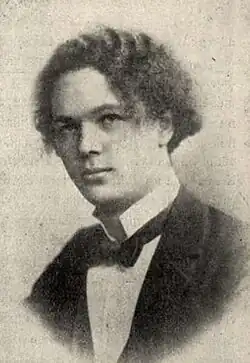Theodor Szántó

Theodor Szántó, also seen as Tivadar Szántó (3 June 1877[1][2][3] – 7 January 1934) was a Hungarian Jewish[4] pianist and composer.
Life and career
Szántó was born in Vienna, then the capital of the Austro-Hungarian Empire. His family name was originally Smulevic, of Jewish and Slavic origin.[5] His musical studies were in Vienna and Budapest, and with Ferruccio Busoni in Berlin 1898-1901.[6] He resided in Paris from 1905, Switzerland from 1914, and Budapest from 1921 until his death there in 1934.[1]
Szántó contributed substantially to the rewriting of the piano part of the third and final version of Frederick Delius’s Piano Concerto in C minor, and he introduced this version at a Prom Concert in London on 22 October 1907 under Henry Wood.[7] For these services, Delius dedicated the Concerto to Szántó.[1] He also played the work at the Proms in 1912, 1913 and 1921.[8] This final version has become the standard version, but Delius's original conception has also been recorded.[9]
Theodor Szántó was an early champion of the music of Zoltán Kodály and Béla Bartók.[10] It was his playing of Bartók's Romanian Dance in 1914 that introduced Arthur Hartmann to the music of that composer.[11] For his part, however, Bartók had little respect for Szántó.[5]
He exhibited an interest in the music of Japan by writing at least three works using Japanese influences (an opera, an orchestral suite, and a piano suite).[1][10]
He also made some piano transcriptions of works by Johann Sebastian Bach and Igor Stravinsky, which reveal a virtuoso technique. His complete piano works [12][13] are recorded by the composer and virtuoso pianist Artur Cimirro for the CD label Acte Préalable
Szanto was considered an important piano teacher.[4] His students included Berta Alves de Sousa in Paris.
Szántó was awarded the Legion of Honour.[5]
Compositions
Original works
Szántó's own original compositions include:
- Violin Sonata, 1906
- Land and Sea Symphony, 1909
- Contrasts, piano suite, 1912[14]
- Variations on a Hungarian Folksong, piano, 1915
- Symphonic Rhapsody, 1917
- In Japan: Essays and Studies in Japanese Harmony based on Native Songs, piano, 1918-22[15] (This work has been recorded by Noriko Ogawa[16])
- Taifun: A Japanese Tragedy in Three Acts[17][18] an opera on a Japanese subject, set to a libretto by Menyhert Lengyel based on his play Typhoon; the opera was premiered in Mannheim on 29 November 1924, and had later productions in Antwerp, Budapest and Vienna
- Japan Suite, orchestra, 1926
- Magyarorszag: Concert Sonata in Hungarian style, violin and piano; dedicated to Eugène Ysaÿe[19]
Transcriptions
- Johann Sebastian Bach: About a dozen transcriptions,[10] including:
- Fantasia and Fugue in G minor, BWV 542, 1904[20] (This has been recorded by Cyprien Katsaris[21] and Marc-André Hamelin[22])
- Prelude and Fugue in A minor, BWV 543,1912[23]
- Prelude and Fugue in C minor, BWV 546, 1914[24]
- Passacaglia in C minor, BWV 582, 1932[25]
- 4 Organ Chorale Preludes, c. 1900[26]
- Aus der Tiefe rufe ich
- Ach bleib bei uns, Herr Jesu Christ, BWV 649
- Jesu Leiden, Pein und Tod on Paul Stockmann's "Jesu Leiden, Pein und Tod"
- Allein Gott in der Hoh sei Ehr, BWV 663
- Igor Stravinsky:
- Suite of five pieces from Petrushka, 1922[27]
- "Fète populaire de la semaine grasse"
- "Chez Petrouchka"
- "Chez le maure"
- "Danse de la ballerina"
- "Danse russe"
- "Marche chinoise" from Le Rossignol[10][28]
- Suite of five pieces from Petrushka, 1922[27]
Discography
- 2017 : Acte Préalable AP0386 – Tivadar Szántó - Complete Piano Works 1 (Artur Cimirro) [1]
- 2017 : Acte Préalable AP0387 – Tivadar Szántó - Complete Piano Works 2 (Artur Cimirro) [2]
References
- ^ a b c d Grove’s Dictionary of Music and Musicians, 5th ed. (1954), Vol. VIII, p. 263
- ^ IMSLP gives his date of birth as 3 March 1877
- ^ IMSLP: Category:Szántó, Tivadar; Retrieved 22 May 2013
- ^ a b Ezra Mendelsohn, ed., Studies in Contemporary Jewry : Volume IX: Modern Jews and Their Musical ...; Retrieved 22 May 2013
- ^ a b c Peter Laki, Bartok and His World, p. 18; Retrieved 22 May 2013
- ^ Larry Sitsky, ed., Music of the Twentieth Century Avant Garde: A Biocritical Sourcebook, p. 85; Retrieved 22 May 2013
- ^ Proms Archive: Prom 57; Retrieved 22 May 2013
- ^ Proms Archive: Theodor Szántó; Retrieved 22 May 2013
- ^ Hyperion Records Delius & Ireland: Piano Concertos; Retrieved 22 May 2013
- ^ a b c d Marc-André Hamelin, Program Notes, Chamber Music Society of Detroit; Retrieved 22 May 2013
- ^ Arthur Hartmann, "Claude Debussy as I Knew Him" and Other Writings of Arthur Hartmann, p. 18; Retrieved 22 May 2013
- ^ "AP0386".
- ^ "AP0387".
- ^ University of Utah; Retrieved 22 May 2013
- ^ IMSLP: In Japan (Szántó, Tivadar); Retrieved 22 May 2013
- ^ BIS: Japonisme; Retrieved 22 May 2013
- ^ Google Books; Retrieved 22 May 2013
- ^ Peter Revers, Das Fremde und das Vertraute: Studien zur Musiktheoretischen und ..., Issue 41; p. 152; Retrieved 22 May 2013
- ^ IMSLP: Magyarorszag (Szántó, Tivadar); Retrieved 22 May 2013
- ^ IMSLP: Fantasia and Fugue in G minor, BWV 542 (Bach, Johann Sebastian); Retrieved 22 May 2013
- ^ Discogs; Retrieved 22 May 2013
- ^ Hamelin plays Bach/Szántó - Organ Fantasy and Fugue in G minor, BWV 542 on YouTube; Retrieved 22 May 2013
- ^ IMSLP: Prelude and Fugue in A minor, BWV 543, 1912 (Bach, Johann Sebastian); Retrieved 22 May 2013
- ^ IMSLP: Prelude and Fugue in C minor, BWV 546 (Bach, Johann Sebastian); Retrieved 22 May 2013
- ^ IMSLP: Passacaglia in C minor, BWV 582 (Bach, Johann Sebastian); Retrieved 22 May 2013
- ^ IMSLP: 4 Orgel-Choralvorspiele von J.S. Bach (Szántó, Tivadar); Retrieved 22 May 2013
- ^ IMSLP: Petrushka (Stravinsky, Igor); Retrieved 22 May 2013
- ^ University of Rochester; Retrieved 22 May 2013